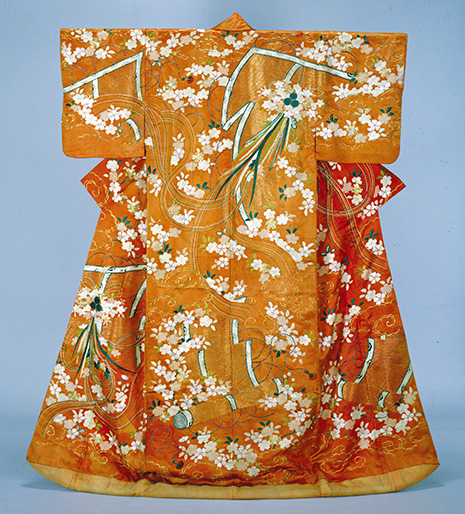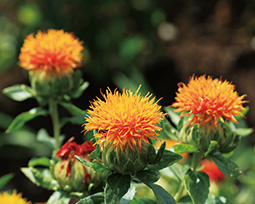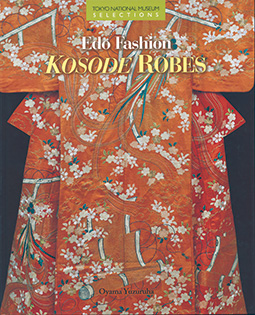May 2023
- PREVIOUS
- NEXT
Formal Outer Kimono ("Uchikake") with Bamboo Curtains, "Kusudama", and Cherry Blossoms
-

Formal Outer Kimono ("Uchikake") with Bamboo Curtains, "Kusudama", and Cherry Blossoms
An uchikake likely worn by a young woman who had married into a wealthy merchant family. Embroidery and Japanese shibori tie-dyeing techniques create a gorgeous pattern representing the Tango no Sekku festivities associated with Japan's Imperial Court.
Photo: ColBase (https://colbase.nich.go.jp/?locale=en) -

Formal Outer Kimono ("Uchikake") with Bamboo Curtains, "Kusudama", and Cherry Blossoms (Back)
Each small white dot is individually tied before the fabric is dyed in a process called kanoko shibori. This method, which became popular in the early Edo period, is known as Kyo kanoko. Embroidery in gold and silk thread add dimension to the pictorial pattern of the design.
-

Safflower was used to create premium benibana-zome dye. -

Oyama Yuzuruha, Tokyo National Museum Selections: Edo Fashion—Kosode Robes, 2020, Tokyo National Museum
This book shows 54 of the over 300 Edo-period kosode robes in the Tokyo National Museum collection and introduces changing fashion trends from the times.

An uchikake likely worn by a young woman who had married into a wealthy merchant family. Embroidery and Japanese shibori tie-dyeing techniques create a gorgeous pattern representing the Tango no Sekku festivities associated with Japan's Imperial Court.
Photo: ColBase (https://colbase.nich.go.jp/?locale=en)

Each small white dot is individually tied before the fabric is dyed in a process called kanoko shibori. This method, which became popular in the early Edo period, is known as Kyo kanoko. Embroidery in gold and silk thread add dimension to the pictorial pattern of the design.
The kimono is more than a garment; it is a symbol of traditional Japanese culture. The kimono of contemporary Japan originated with the kosode (a garment with small wrist openings) of the Edo period (early 17th century to mid-late 19th century). This issue introduces a selection from the Tokyo National Museum collection of kosode, the everyday dress of people of all classes during the Edo period.
What vibrant colors! Dyed with safflower, a luxury dye in the Edo period known as benibana-zome, this uchikake is a kosode robe that would have been worn over the kimono beneath. The robe features thick cotton padding at the edge to make it easier for the hem to drag. The glossy rinzu silk satin damask fabric features a woven ground pattern of a crane, a symbol of longevity and good fortune, flying across the sky. The design is further decorated with cherry blossoms in full bloom among the clouds and misu* bamboo blinds swaying in the wind.

Fluttering in the wind alongside the misu are kusudama, ornamental scented balls made of musk, agarwood, and clove wrapped in silk. The ornaments are covered with stylized flowers made to look like satsuki azaleas and tachibana orange blossoms, with irises, mugwort, and five-colored tassels** hanging below. On May 5, the day of the Tango no Sekku*** ceremony, kusudama were hung on misu blinds throughout the Imperial Court to pray for peace and harmony, and left on display until Choyo no Sekku on September 9. Ornamental motifs like these, representing the situations from annual events at the Imperial Court, were in fashion among townswomen, who adored the courtly life. Incorporating seasonal motifs into a single painting-like design, as this uchikake does, is a unique characteristic of Japanese kimono.
A variety of traditional Japanese techniques were in fact used to decorate kimono in the Edo period. In addition to kanoko shibori tie-dyeing (see photo of back view), this uchikake also employs washishu Japanese embroidery, which saw dramatic advances in the Edo period. Washishu is most notable for its use of silk embroidery floss with very little twist, dyed in such colors as hiwa-iro (light olive yellow), moegi-iro (light green), and beni-iro (red).**** Stitches covering large areas of fabric are used to create patterns with dimension and texture. This technique gives the embroidery floss a jewel-like shimmer, highlighting the luster of the silk thread to great effect. Strands of gold embroidery floss—made by wrapping thinly cut strips of gilded washi Japanese paper around a core of silk thread to form a cord—are individually stitched in place to create the pattern. This ingenious technique brings a golden glow to textiles that dyes cannot.
While the uchikake is very splendid in design, its short sleeve length indicates that it was worn by a married woman, as opposed to the furisode (long-sleeved kimono), which was made for young, unmarried women. This robe was likely worn on formal occasions by the young wife of a prosperous city merchant. Having gained economic power in the Edo period, the merchant class proudly wore kimono that were more extravagant and lavish than those of high-ranking samurai or ladies of the court.
The Art of Fashion
Japanese Gallery (Honkan), Room 10
Tokyo National Museum
Formal Outer Kimono ("Uchikake") with Bamboo Curtains, "Kusudama", and Cherry Blossoms is on display until June 18, 2023. It has not been planned when this work will be exhibited next.
Ueno Park 13-9, Taito-ku, Tokyo
Opening Hours: 9:30 am – 5:00 pm
*Last admission 30 minutes before closing
Closed: Mondays (open on public holidays and closed the following day), New Year's holidays, intermittently as required
https://www.tnm.jp/?lang=en

This book shows 54 of the over 300 Edo-period kosode robes in the Tokyo National Museum collection and introduces changing fashion trends from the times.
* Thin strips of split bamboo or reeds woven together with thread into a blind-like curtain called sudare, which are hung in front of house doors and windows. They function as sunshades or screens, while still allowing the wind to pass through. The high-end version of sudare edged in cloth is called a misu.
** Five tassel colors: blue, yellow, red, white, and black
*** Sekku refers to the day of the year on which the seasons change. The five sekku seasonal festivals that had been held since ancient times at the Imperial Court to ward off evil spirits have been taken up the general public, as well. Tango no Sekku is now generally marked as a day to pray for children to grow up healthy. Choyo no Sekku is also called Kiku no Sekku (Chrysanthemum Festival) and is marked by praying for good health and long life and a cup of sake topped with floating chrysanthemum petals.
**** These are all traditional Japanese colors. Moegi is a bright green, the color of young leaves in early spring. Hiwa-iro is even brighter with stronger yellow tones, while beni-iro is a yellowish red.
- PREVIOUS
- NEXT

